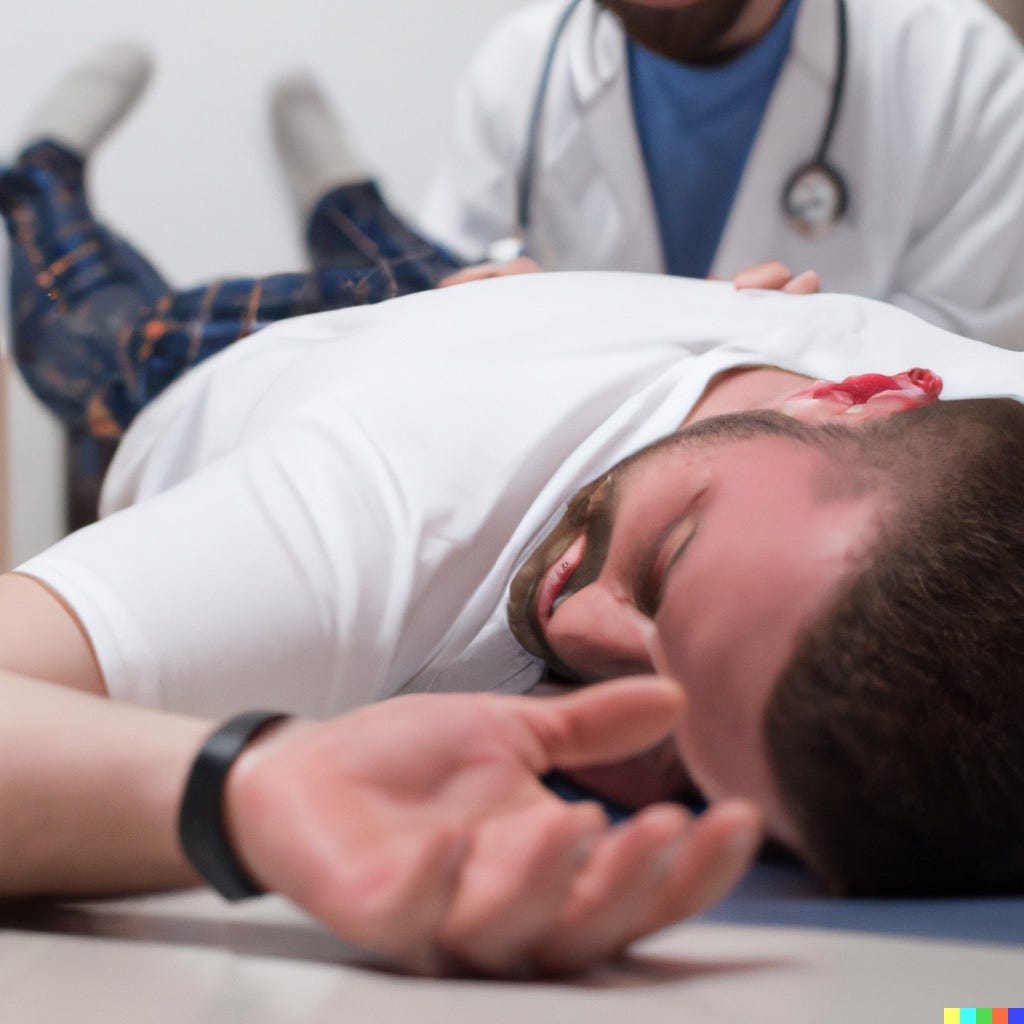A patient of mine experienced one of these dramatic episodes this past week, prompted by the removal of a bladder catheter. His wife was present and was quite frightened by his two-minute swoon, but our experienced nursing and medical staff responded promptly and calmly aided him (and her) and he (and she) are none the worse for the experience. Considering that 40% of the population will have one or more of these fainting episodes in their lifetime, I deemed the topic worthy of a write up.
Have you heard of vasovagal syncope? Don't worry if you haven’t; it's not the latest dance craze, but actually a fancy term for a brief “lights out” moment that some of us may experience from time to time. In medical-speak, it is also known as “neurological-mediated syncope.”
(Thank you DALL E2 for image above)
Definition & Behind the Scenes: Alright, let's break it down: Vasovagal is a word combo concerning blood vessels (vaso) and the vagus nerve (vagal). The vagus nerve is the 10th cranial nerve that governs control of the heart, lungs, and digestion. In vasovagal syncope, stress or another trigger causes this nerve to throw a little tantrum, leading to a loss of vascular tone and thus a "temporary fall in pulse and blood pressure” party with special guests including fainting, sweating, and maybe even a touch of nausea.
Triggers: There are many triggers that could send you on such a fainting adventure: Blood drawing, the sight of blood, and experiencing or observing medical procedures are key triggers that may function like waving a wand that says, “Abracadabra, faint!” Emotional stress, pain, low blood sugar, suddenly standing after prolonged sitting, hot showers – are all possible triggers that may prompt you to join the fainting party.
The Basics: Think of vasovagal syncope as a magic trick where the autonomic nervous system decides it's time for a quick nap. Your heart rate drops, blood pressure takes a dive, and suddenly, your brain gets a short vacation – usually for just a minute or two. During this performance, you might look a little pale, even greenish in hue, and perhaps even drenched in sweat as if you've run a marathon. But hey, it’s not a heart problem; it’s just your nervous system flexing its muscles... or not flexing them, in this case.
Family Fainting Stories: Guess what? Vasovagal syncope has no favorites. It’s a democratic fainting phenomenon that can hit anyone. My dear kids and I are rather "vagal" and have our own "fainting badges." My son turns into a fainting superstar whenever his blood is drawn. He's even got his own “pre-game” ritual involving chugging water and only having his blood drawn while lying supine on a stretcher. My youngest daughter? She's got some stories too, including fainting at a funeral – talk about making an entrance! As for me, as a child I once took a knee after a bagel-cutting mishap.
In my kitchen, I tried to divide,
A bagel so fluffy and wide.
But a slip of the knife, Led to trouble and strife,
Vaso-vagal, I swayed like the tide.
(Thank you Chat GPT for the limerick!)
On the receiving end of my first prostate exam, I hit the deck and the next thing I knew a nurse was waving smelling salts around my nostrils! So much better to give than to receive! On another occasion, my dentist had me in a headlock with a pair of pliers on one of my molars, struggling to yank the tooth out and before I knew it, I was out.
Why the Faint? One idea is that it’s our body’s way of conserving blood in case of traumatic emergencies. For example, if you fall off your motorcycle, the fainting fairy might show up to help prevent excessive blood loss. Less blood pressure, less bleeding.
Surviving the Faint: Right before the big event, there's usually a little preview – dizziness, warmth, lightheadedness, nausea, maybe even some blurry or tunnel vision, buzzing or ringing in the ears, sweating or clamminess and often yawning. This prodrome is your body’s way of saying, “Buckle up, we're going on a fainting roller-coaster!” Lying or sitting down and elevating your legs can help put the brakes on the whole ordeal. If standing, crossing your legs and tensing them, along with the muscles of your abdomen, buttocks, and arms will help the cause by pushing blood back to the heart.
Faint-Proofing Yourself: Avoiding triggers is ideal, but sometimes life just throws you a curveball. Staying well hydrated is like giving your blood pressure a little pep talk. So, keep that water bottle handy!
Bottom Line: Vasovagal syncope is the roller-coaster ride your body loves to surprise you with. Just remember, even superheroes have their off days. It's not a sign of weakness, but rather an ultra-sensitive nervous system. Stay hydrated, keep an eye out for those sneak-attack symptoms, and remember, you're not alone on this fainting adventure!
Wishing you the best of health!




